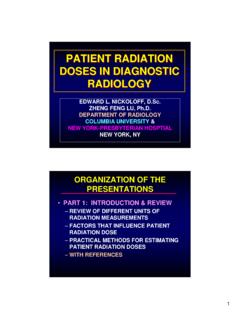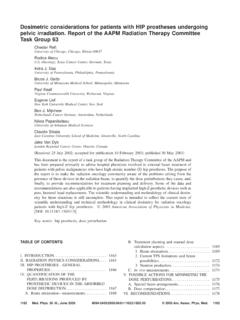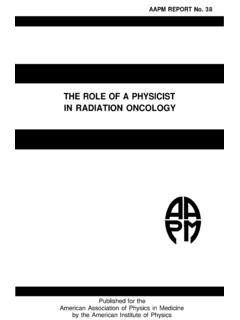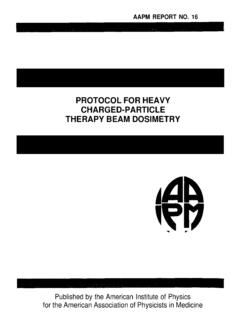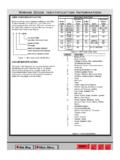Transcription of PET/CT Facility Design - AAPM
1 PET/CT Facility PET/CT Facility DesignDesign2010201020102010 American College of Medical American College of Medical PhysicsPhysicsJon A. Anderson, PhD Jon A. Anderson, PhD ACMP, of RadiologyDepartment of RadiologyThe University of Texas Southwestern Medical Center at DallasThe University of Texas Southwestern Medical Center at DallasWhat Is Different When You Have PET/CT i YF ilit ? PET/CT in Your Facility ?1) 511 keV energy-increases exposure rate from doses,increases exposure rate from doses, patients-greatly increases thickness of required hi ldid t ditishielding compared to diagnostic rooms 2) requirements for patient handling during injection and uptake phase3) Combinedmodality scanners3) Combined modality scanners ( PET/CT ) require consideration of both gamma-ray and x-ray hazardsACMP, You can affect neighboring modalitiesThe 18F-Injected Patient as a Source (f diffii2003)(average of different investigators, 2003) ( Sv/hr) (mrem/hr)/mCiall at 1 m from surface of body average value (mrem/hr)/mCibody, average value from several investigatorsLt ( Sv/hr) (mrem/hr) ( Sv/hr) (mrem/hr)
2 /mCiAnteriorLateralnot as anisotropic as itcompare this to 0 014 (S/h ) ( Sv/hr)/MBqIf ianisotropic as it might ( Sv/hr) (mrem/hr)/mCifor99mTc18F valuesACMP, ) (mrem/hr)/mCiInferiorfor Tc. F values factor of 8 larger!A Revealing Comparison of Lead RitXRPETR equirements: X-Ray vsPET# Half VlLead Thickness Required(i htt 1/16)Value Layersmm (inches, to next 1/16)X-ray 1 PET2 Even a single half-y(Average primary spectrum for rad room)10 044 (< 1/16 )53(1/4 )single half-value layer for PET is (< 1/16 ) (1/4 ) (< 1/16 ) (7/16 ) (< 1/16 ) (3/4 )an expensive proposition!()() (< 1/16 ) (1 5/16 ) (< 1/16 ) (1 13/16 )ACMP, NCRP 147: Structural shielding Design for Medical X-Ray Imaging Facilities2. Simpkin, 2004, developed for AAPM Task Group on PET Facility ShieldingA Revealing Comparison of Lead RitXRPETB ottom Line: for DX shielding , we find that requirements : X-Ray vsPET#HVL'sLead Thickness Required(itt 1/16)1/16" lead is (usually) the answer, with some to spare.
3 We usually make very conservative calculations because HVL s are cheapmm (in, to next 1/16)X-ray 1(average primary forPET2 Even a single half-calculations, because HVL s are true in PET. As we will see, normally we(average primary for rad room) (< 1/16) (1/4)single half-value layer for PET is Not true in PET. As we will see, normally we need 1-4 HVL's of shielding (1/4 -3/4 !). We tend to put just what we need, due to $$$. (< 1/16) (7/16) (< 1/16) (3/4)an expensive proposition!Implication: At every protection point, we need t i ld llthtbtibti (< 1/16) (1 5/16) (< 1/16) (1 13/16)to include all sources that can be contributing to the dose at that point ( multiple injection rooms scan rooms CTcontributions etc)andACMP, NCRP 147:Structural shielding Design for Medical X-Ray Imaging Facilities2.)
4 Simpkin, 2004, developed for AAPM Task Group on PET Facility Shieldingrooms, scan rooms, CT contributions,etc.), and make the best possible estimate to save $$$. Workflow at the PET Center (FDG Whole Body Scans)(FDG Whole Body Scans)Receive dosesArrival of patient**Injection of PtUptake of pharmaceuticalAssay of dosePt instruction and prep30-90 min**5-20mCiTransport Pt to scannerHave Pt empty bladder**520 mCiPosition PtScan5-20 min5-10 min**steps with highest technologist*QA Check of ScanRelease PtRead studytechnologist exposure*ACMP, to PACS or MediaMagnitude of Technologist EConsistent with conventional nuclearExposureConsistent with conventional nuclear medicine practice, most of technologist dose comes from positioning, transport, and Doses0150djaverage dose/procedure HandledMBqmCi)< 10 Sv (1 mrem)
5 Sv/M( ChiseaChisea McElroy UTSWR obertsGuilletBiranYester AverageACMP, on Technologist Exposure1) Individual technologist dose should drop as experience increasespOver a two year period with the same technologists, we saw a 40% didi tiditti it hdl ddecrease in radiation dose per unit activity ) Sv/(MBq injected) 370 MBq (10 mCi) injected/pt 10 pt/day mSv (1660 mrem) (<5 rem, >ALARA trigger) 9 Months: mSv (1250 mrem) (> declared pregnancy limit)ACMP, Suggestions to Minimize Th l itDTechnologist DoseMinimize handling time. Use unit tungsten syringe shields, employ syringe carriers, ii i h dlitransport carts, etc. to minimize handling patient before injection Minimize contactInstruct patient before injection.
6 Minimize contact IV access with butterfly infusion , other personnel for hot patient transport. PET Facility Tour: University of Texas Southwestern Medical Center at DallasSouthwestern Medical Center at Dallas(2001-2007)Strip shopping center, uncontrolled occupancies on both sidesFuture CameraRoomOffice 1 DockLaundryScanUtilityReadingRoomRadioac tive MaterialsOffice 3 Offi2 Hot LabLSidorEast CorridorScanRoom 1 Office 2 Injection#2 Injection#1 HotToiletScanRoom 2 South CorriControlWest CorridorBreakRoomStorageReception & WaitingBusinessOfficePatientsACMP, Facility Tour: University of Texas Southwestern Medical Center at DallasSouthwestern Medical Center at Dallas(2001-2007)Future CameraRoomOffice 1 DockLaundryScanUtilityReadingRoomRadioac tive MaterialsScanR1 Office 3 Office 2 InjectionHot LabScanR2orridorEast CorridorIf you can get involved in the architectural planning, you can save iiiRoom 1 West CorridorInjection#2 Injection#1 HotToiletRoom 2 South CoControlsome money, by using distance instead of CorridorBreakRoomStorageReception & WaitingBusinessOfficePatientsACMP, Lab Details: Dose Storage AAreaNotes:1) Floor protection (containers eigh > 66 lbs)weigh > 66 lbs)2) Space needed depends on how often deliveriesoften deliveries are made.
7 May have >100 mCi here at a time, ,even for one scanner3) Extra ACMP, may be requiredHot Lab Details: Dose Assay and PtiAPreparation AreaNotes:1) Calibrator )convenient to dose storage2) L Block close to calibrator3) Note use of ispecial PET carrier for syringe4) Note L4) Note L Block: thick window, 2" lead 2"leadACMP, 2 lead wrap-aroundHot Lab DetailsNotes: 1) All this lead requires solid support -- have a heart-to-heart talk with the cabinet maker2) Counter mount of calibrator decreases tech exposure3) Extra shielding required on well counter to shield from sources in scanner, calibration sources, patient in scanner, ) Uttihi ld fdd titACMP, Use tungsten syringe shields for dose reduction to Room DetailsNotes:1) Injection roomHot labPET/CT bPET/CT bayare most likely areas to need shielding2) To minimize anomalous uptake-minimize externalminimize external stimuli (false uptake!
8 -keep patient quiet and still on gurney or in gyinjection chair3) Need adjacent hot 4) Indirect lighting,curtains, noise control ACMP, for patients to use after uptake desirableCalculation Formalism Proposed by T k G108 Gl FTask Group 108: General FormB, the required barrier transmission factor, will be calculated asP*d2B = P * d2 * T * Nw* A0* Ftot* t * Rt)P = target dose in protected area (per week, hour, etc.) [ Sv]d = distance from source (patient) to protected point [m] =dose rate constant [( Sv/hr)(m2/MBq)] dose rate constant [( Sv/hr)(m/MBq)]T = occupancy factor (NCRP 147 or specific information)Nw= number of patients per time period corresponding to PA0= injected activity [MBq]0 Ftot= factor encompassing physical decay of the injected dose and possible elimination from body = Fphys* Felimt = integration time (time the source (patient) is in the room) [hr]ACMP, "reduction factor" (accounts for decay during dose integration period) Site Evaluation for PET ShieldingUses of adjacent spaces (including above and below)
9 And occupancy factors for them# patients/weekisotopes to be used, activity/pttfPETtditbfd(biWBdi)types of PET studies to be performed (brains, WB, cardiac)uptake time and scan time for this equipment/study/centerdose delivery schedule (once a day?, multiples?); maximum activity on handCT technique factors (kVp, mAs/scan [depends of # beds])# scans per patient (additional diagnostic scans?)tf"PET" CTkl dt dACMP, of "non-PET" CT workload expectedRadiation Sources to Include in the shielding PlanShielding PlanDoses (pre-injection) in Hot Labrequire isotopic workload Calibration sources for scanner parameters:pts/wk, mCi/pttktiPatient (post injection, in uptake rm)*uptake,scan timesisotope type and delivery schedsPatient (in scanner, hot toilet)delivery schedsrequire CT x-ray workload factorsCT x-ray source (for PET/CT )workload factors, techniques, include non-PET ACMP, workP.
10 Radiation Protection TargetsLimitationsALARAper 10 CFR20 Action LimitRadiation workers50 mSv/yr5mSv/yrRadiation workers50 mSv/yr5 mSv/yr(5000 mrem/yr) (500 mrem/yr)Pregnant worker's fetus 5 mSv/9 mo Targets(500 mrem/9 mo)Members of public1 mSv/yrTargetscontrolled areas:100 Sv/wk orpy(from each licensed operation) (100 mrem/yr)in any hour, not to mSv(2 mrem)100 Sv/wk or 10 mrem/wkuncontrolled areas: (2 mrem)20 Sv/wk or 2 mrem/wkACMP, ALARA -- As Low As Reasonably AchievableN: Maximum Workload EstimationPET Facility Throughput Example:90 Minute Uptake, 30 Minute Scan1515i/d91113umber15 patients/day three uptake rooms579atient NPhaseUptake13 PapScanning7:00 8:00 9:00 10:00 11:00 12:00 13:00 14:00 15:00 16:00 17:00 Time of DayACMP, = (tworkday-tuptake)/tscan_rm# uptake areas = tuptake/tscan_rm18F: A Plethora of Dose Rate Constants for Point Sources (TG-108)18F Rate ConstantsSI UnitsConventional UnitsExposure Rate ( R/hr) m2 (mR/hr) m2/mCiAir Kerma Rate ( Sv/hr) m2 (mrem/hr) m2/mCiConstantEffective Dose Equivalent (ANS-1991) ( Sv/hr) m2 (mrem/hr) m2/mCiTissue Dose ( Sv/hr) m2 (mrem/hr) m2/mCiDeep Dose Equivalent ( Sv/hr) m2 (mrem/hr) m2/mCiTG-108 recommends(ANS-1977)Maximum Dose (ANS-1977) ( Sv/hr) m2 (mrem/hr) m2 ( Sv/hr) (mrem/hr)/mCiACMP, F-18 bare source.


